What It Took to Film Theyyam—Kerala’s Sacred 1500-Year-Old Dance Few Outsiders Ever Witness
Vinod Panicker Thillankeri hasn’t moved a muscle in the last two hours. It feels like an eternity to him.
But, he must lie still; it’s not every day you get to turn into God.
Men hustle around him. They slip a chilambu (a metal anklet) onto his feet; on his boldly-coloured cheeks they paint deft strokes of red — the exact shade is achieved by mixing turmeric and limestone; then ease him into the voluminous skirt — a moodboard of blacks, reds, and whites held in place by armlets, chest plates, anklets and belts with their shells and beads clinking with every step he takes. Once deemed complete, the final touch is added — a 21-foot mudi (headdress).
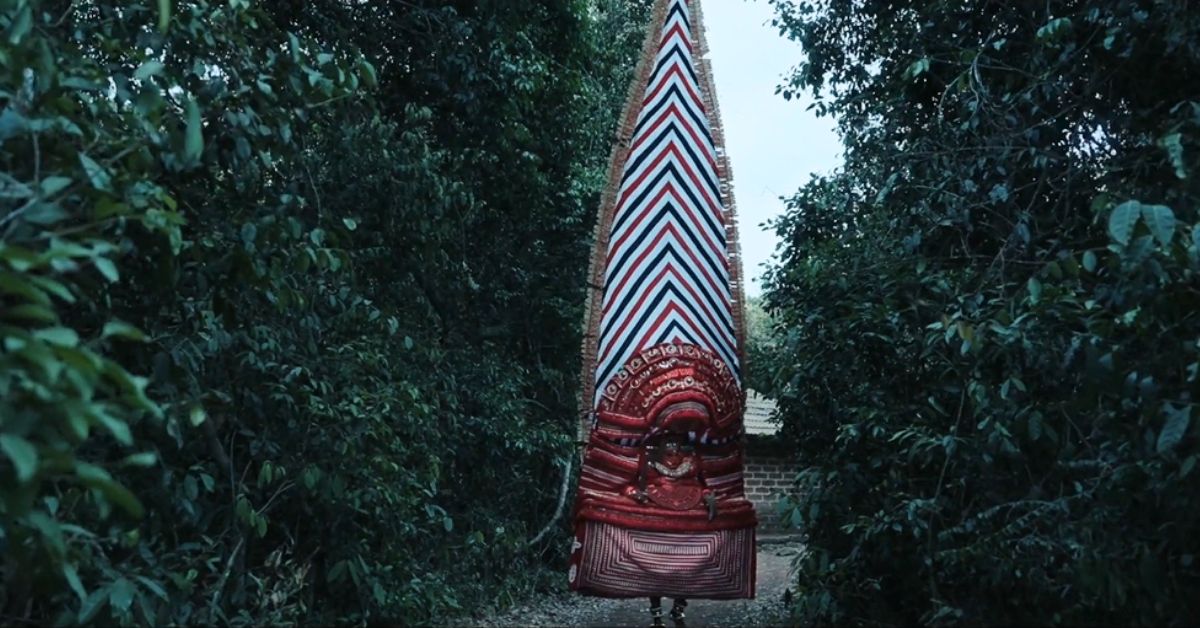 The 21-foot mudi (headdress) is placed atop the performer’s head, completing the costume; Picture source: Still from ‘Dance of Gods’
The 21-foot mudi (headdress) is placed atop the performer’s head, completing the costume; Picture source: Still from ‘Dance of Gods’
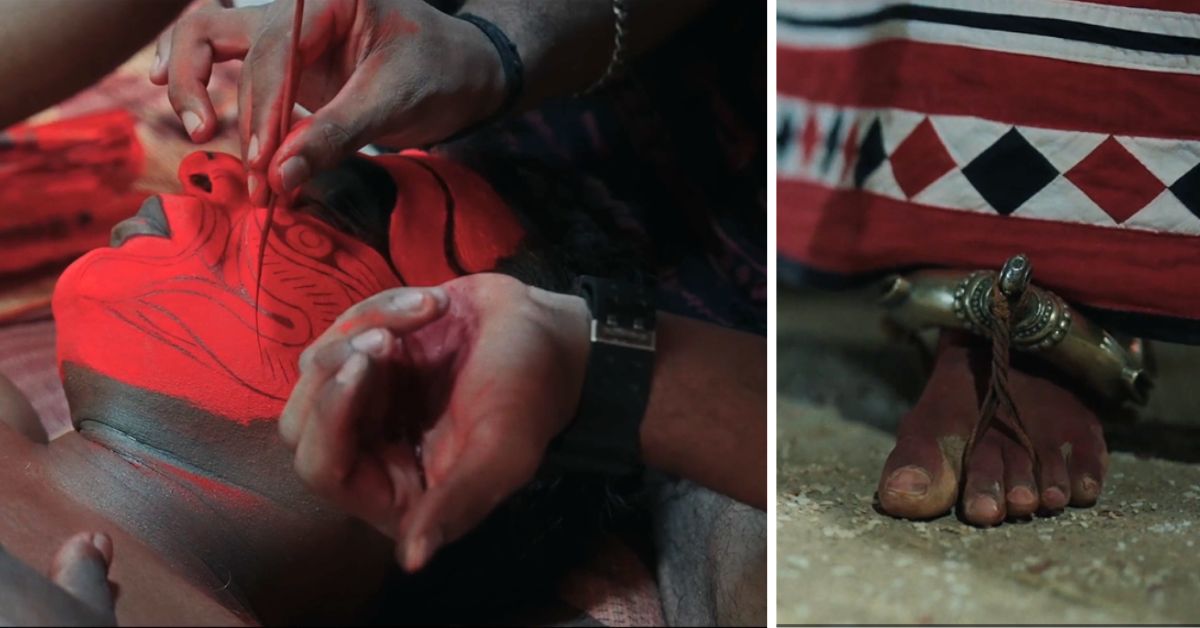 Deft strokes of colour made from natural dyes are painted on the faces of the performers while their feet are adorned with metallic anklets, Picture source: Still from ‘Dance of Gods’
Deft strokes of colour made from natural dyes are painted on the faces of the performers while their feet are adorned with metallic anklets, Picture source: Still from ‘Dance of Gods’
Minutes later, it is no longer Vinod who walks out of the forest; it is God.
The litmus test lies in a dance he performs atop a four-legged rickety stool. As he swirls, so does his chromatic avatar. The headgear, too — precariously teetering on edge — obliges with the choreography. In Vinod’s hands are two flaming fronds. He wields these with master precision. The people around him are careful, but Vinod dances undeterred. He’ll only stop when God wants him to.
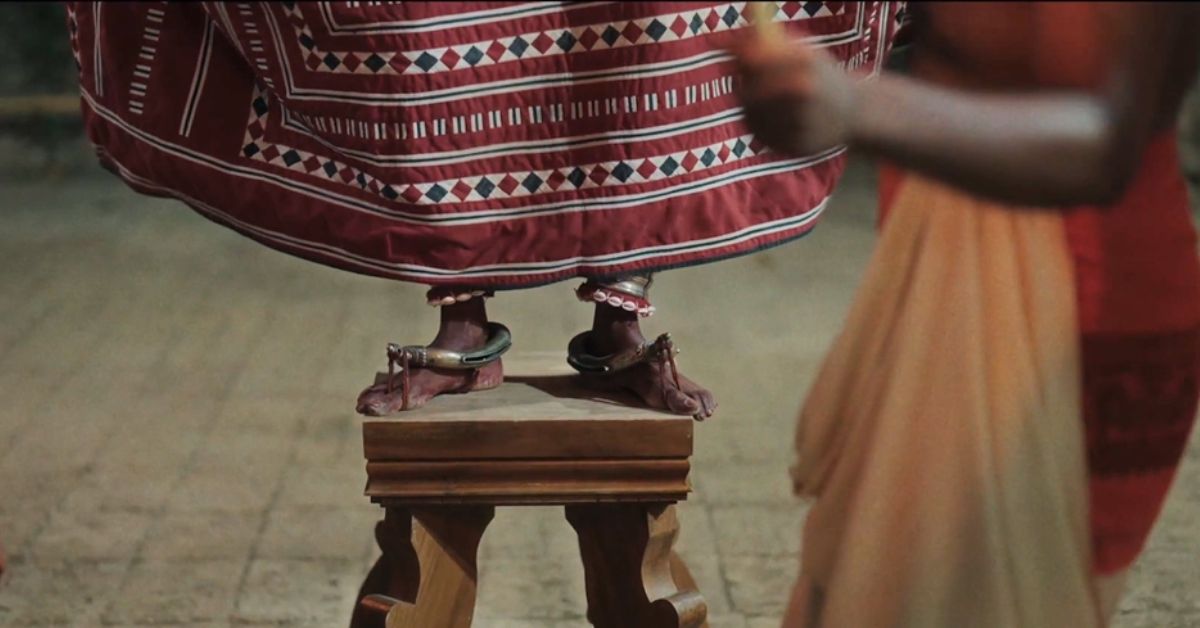 The theyyam performers are bestowed with divine energies as they proceed with the dance, Picture source: Still from ‘Dance of Gods’
The theyyam performers are bestowed with divine energies as they proceed with the dance, Picture source: Still from ‘Dance of Gods’
This isn’t make-believe. It’s theyyam, a time-tested ritual that you can witness for yourself if you head to Kerala between October and May (the Malayalam calendar dictates the dates), when the villages come alive with this 1500-year-old ritualistic dance native to the state. It’s a kaleidoscopic whirlwind, distinguished by moves that mere mortals can’t pull off — think devouring live chickens and throwing oneself face-first into a pile of hot embers.
The secrets of the theyyam
The sky holds its breath as Vinod performs. The audience sits rapt with attention. Two sets of eyes among them haven’t blinked at all. One belongs to Zafar Mehdi (31), a Lucknow-based filmmaker, the other is his camera.
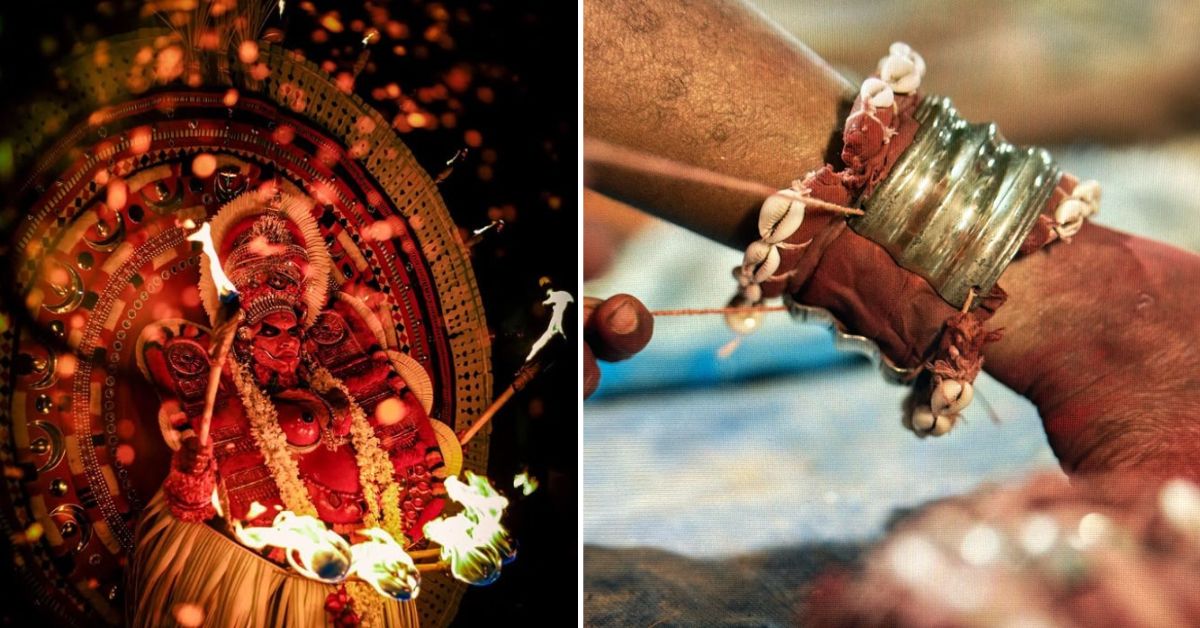 The theyyam dance is a sacred ritual that happens in Kerala from October to May and sees cultural revelry, Pictures source: (L): Theyyam, (R): Still from ‘Dance of Gods’
The theyyam dance is a sacred ritual that happens in Kerala from October to May and sees cultural revelry, Pictures source: (L): Theyyam, (R): Still from ‘Dance of Gods’
When Zafar set out to document the theyyam in Kerala, he wasn’t expecting an easy feat. But his genius helped him translate the esoteric energy he was witness to onto the screen. And it’s won hearts. The 22-minute documentary ‘Dance of Gods’ was selected to be screened at the 15th Dada Saheb Phalke Film Festival.
Revisiting the process of documenting theyyam, he says it wasn’t easy. There are so many conjectures surrounding deity worship, he learnt. Clarifying the legend, one local Prabhakarna C V explained that historically, ceremonial practices were performed before battles by the ancestors of King Pazhassi Raja. After the British defeat of the king, these traditions ended, and local folklore speak of troubling events that followed, affecting common people.
The dances and rituals of the present-day theyyam reflect this cross-fertilisation of culture, legend, and aesthetics.
‘Spellbinding’ is how most describe the dance to be. There’s a beautiful kind of dexterity to it, as the performers move in sync to the beat of chenda drums; chanting fills the air. The dances are an ode to stories about the gods and ancestral spirits. But, as Zafar clarifies, it isn’t just a spectacle. “These performers believe that God enters them and that’s how they can do what they do.” Divine energy helps them navigate the perils of fire and fear.
Having first heard about theyyam while he was studying architecture in Calicut in 2018, Zafar revisited the idea of documenting it in 2024.
“The theme appealed to me because it was cinematic, but there was also a certain darkness to it. This darkness is not something the locals feel. For them, it is a cultural celebration.”
He continues, “I knew I wanted to make a documentary that was cinematic but still hinged on storytelling. I wanted to show the audience things without me explicitly telling them what to look out for. I wanted them to experience it as if they were with me while I was seeing the theyyam.”
And the final result is exactly that, as I can testify. A beautiful tapestry where culture meets cinema.
A cultural pause in the state’s breathless routine
Translating to ‘incarnation of God’ theyyam is simply an ancient folk ritual that combines theatre, mime and worship. What sets it apart is that kolams (performers) witness a pivotal departure from their human form as they step into a god-like trance, complete with elaborate headdresses and costumes that mimic the deities.
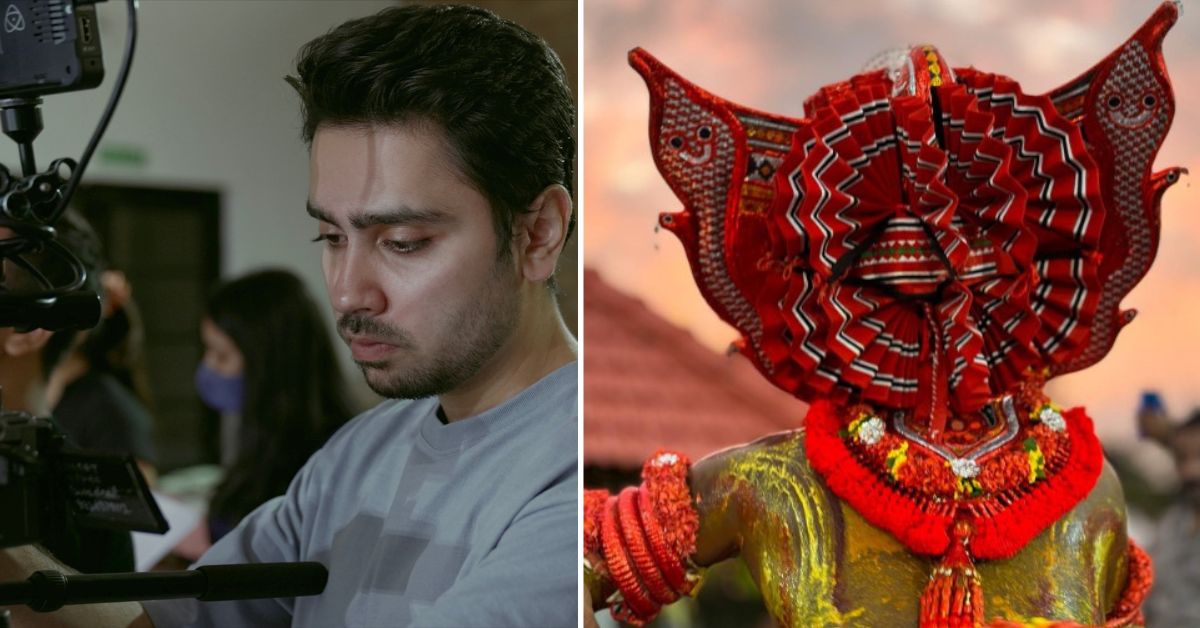 Zafar Mehdi is a documentary filmmaker whose work touches upon cultural stories, Pictures source: (L): Zafar, (R): Sabin Uralikandy
Zafar Mehdi is a documentary filmmaker whose work touches upon cultural stories, Pictures source: (L): Zafar, (R): Sabin Uralikandy
There exist over 400 different types of theyyams across northern Kerala and Karnataka. As theyyam expert PS Kurian shared in an interview with BBC, only natural materials are used to make the dyes, while the mudi is hand-fashioned from areca nut, coconut, peacock feathers and shells.
Culture lies in every fold of the outfit; from the skirt for Kathivanur Veeran Theyyam, which is made from bamboo pieces wrapped in red cloth, to the ornaments worn, which include ekir (a long silver teeth ornament), the katakam (bangles worn by male performers), and chutakam (bangles worn by female performers), and a silver crown adorned with small serpent heads topped with red flowers.
The theyyam is a sacred ritual. And so, performers must abstain, fast, pray, and meditate before a performance.
And while the performers prepped, Zafar waited in the shadows, eager to watch the dance unfold.
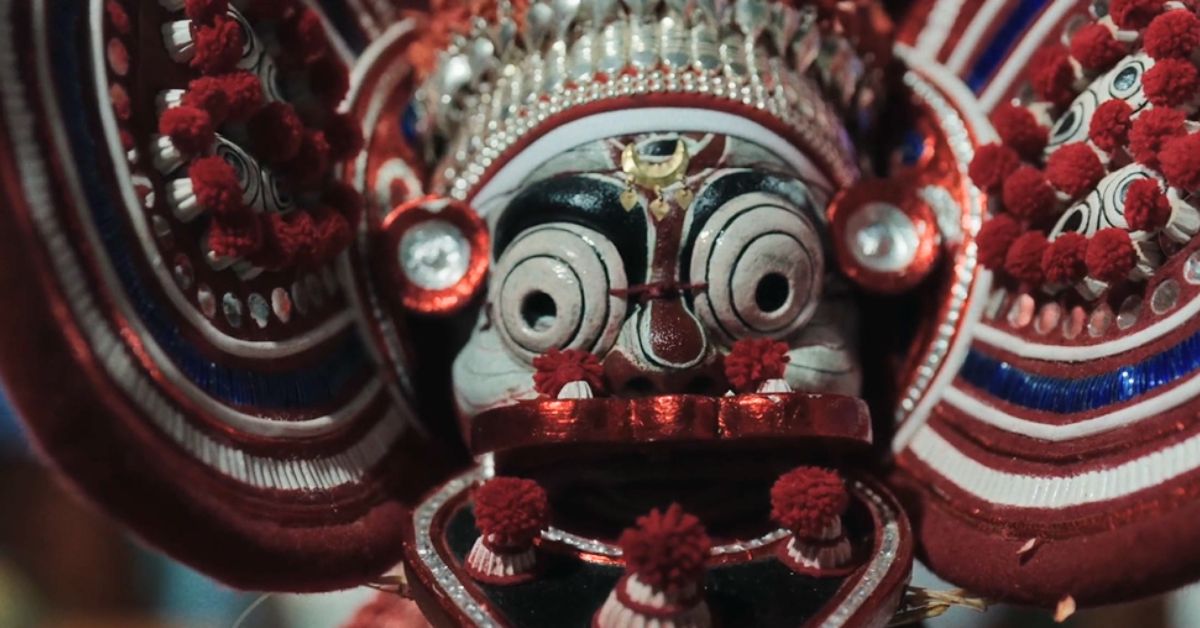 There exist over 400 different types of theyyams across northern Kerala and Karnataka, Picture source: Still from ‘Dance of Gods’
There exist over 400 different types of theyyams across northern Kerala and Karnataka, Picture source: Still from ‘Dance of Gods’
“We stayed in Kannur for 10 days. We wanted to capture one of the theyyams in Neeliyar Kottam — a sacred grove, the kind where theyyams are held — and we managed to document one of the performers walking through the forest in their attire. The tough thing is that you can’t tell them what to do. You have to find a way to capture without interfering with the rituals,” he shares.
Recalling how the theyyam demands courage from not just the performers but also from the audience, he says, “There was this time when the people — hundreds of them—started chanting prayers and creating sound with their instruments. I was a little scared. The energy is very different from what you would normally witness.”
Prajoon CV agrees. He’s been carrying on the legacy of theyyam for years now. “We are ordinary men. The headgear and costumes are heavy, and if not for the blessings of God, we wouldn’t be able to carry the weight,” he admits.
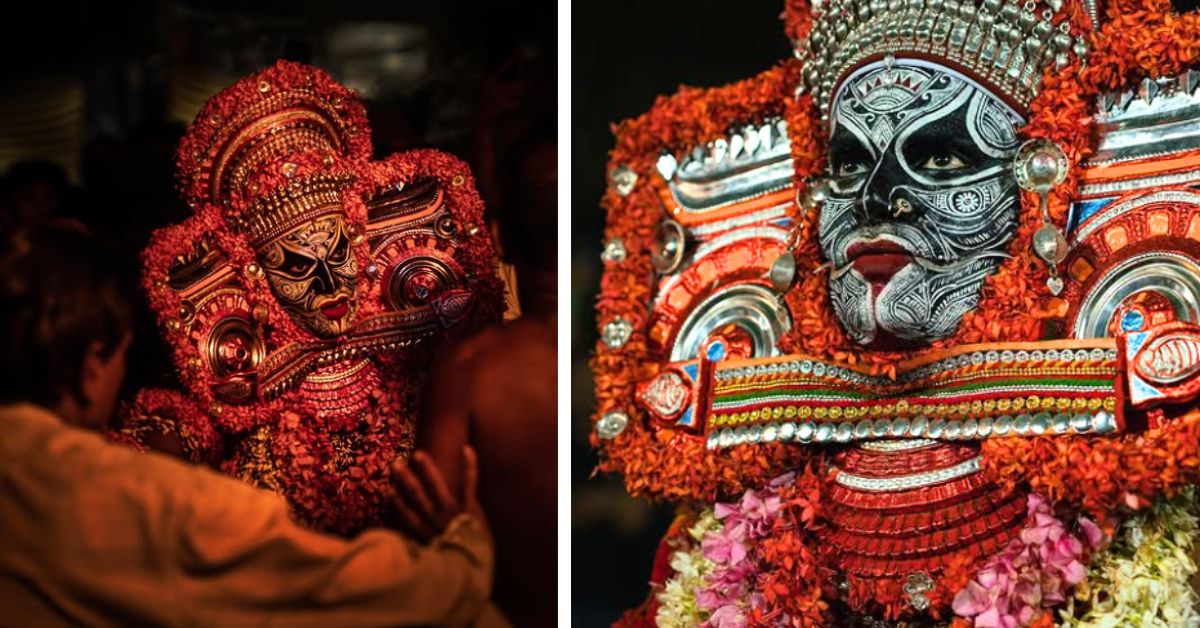 The elaborate costumes, makeup, and dance movements, accompanied by traditional music, make theyyam a visually stunning and powerful experience, Pictures source: Mahendra Bakle
The elaborate costumes, makeup, and dance movements, accompanied by traditional music, make theyyam a visually stunning and powerful experience, Pictures source: Mahendra Bakle
But these blessings don’t mean the absence of discomfort.
Prajoon shares that body pain and excessive sweating are common. Among the forms of theyyam some of the most popular ones are Bali theyyam based on the character of a heroic warrior who is tragically killed; Gulikan vellatam, a series of rituals preceding the theyyam recital; Kandanar Kelan theyyam, which involves running through the pyre; and Devakoothu, the only one that is ritually danced by a woman.
Each necessitates intrepidity.
But as extensive as theyyams are, Prajoon says they are the reason the state gears up in festive revelry. “When it’s over, we miss it.”
With the advent of May, the theyyams bow out of Kerala. And just like that, Prajoon and the other performers must fold back into their existence as mortals.
Sources
Theyyam by Kerala Tourism.
News